10 Key X (Twitter) Metrics to Track in 2025
Table of contents
Twitter is one of the most powerful marketing tools available. However, tracking the right metrics is essential to make the most of it. Here are some key Twitter metrics Marketers need to track in 2025.
The success on Twitter, you need to increase the number of tweet impressions, followers, brand awareness, and engagement rate.
It doesn’t happen overnight.
To run a successful Twitter marketing campaign, you must follow the right metrics closely.
But how do you differentiate the valuable metrics from the vanity ones?
After all, you could be tracking KPIs that aren’t representative of your Twitter performance. In that case, you won’t be able to correctly assess your social media presence and adjust your Twitter marketing strategy.
In this blog post, I’ll show you the Twitter metrics you should follow to boost your online presence, find new leads, and increase sales.

Ready? Let’s dive in!
Key Twitter Metrics:
01 Top tweets
One way to measure your Twitter success is by tracking your top tweets.
Top tweets are those that are retweeted or liked by a large number of people, and they can help amplify your message and reach a larger audience.
This metric can help you understand:
- Which of your tweets resonate with your audience,
- The topics that are most important to them,
- Engagement level, showing how much your followers engage with your content,
- Which content resonates with your followers, and adjust your social media strategy accordingly.
So if you’re looking to boost your Twitter presence, make sure you’re paying attention to your top tweets.
How to track:
You can check your top tweets in the Twitter Analytics account overview.
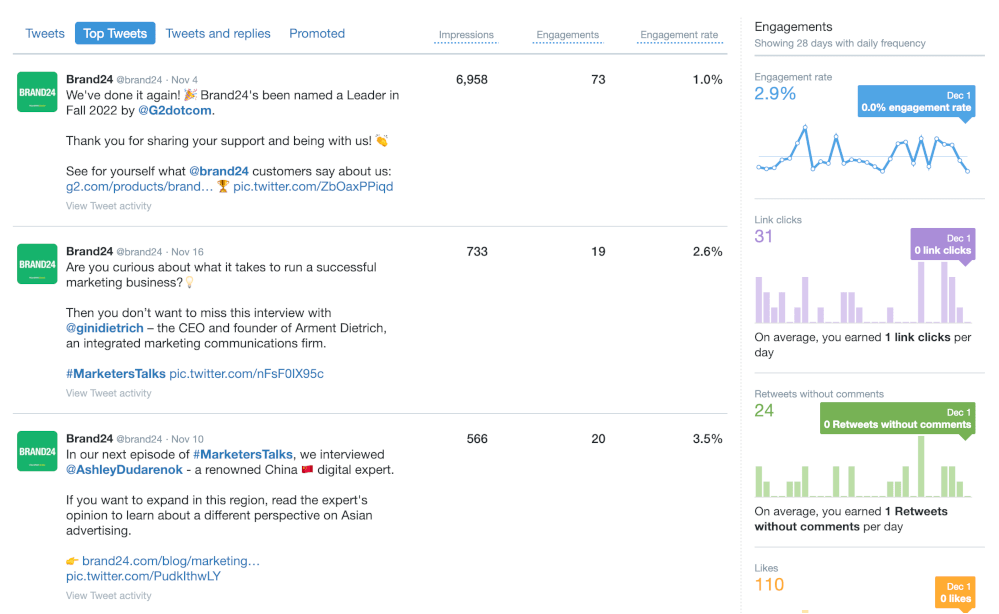
Brand24 is a tool that tracks key Twitter metrics.
02 Twitter followers
We run our Twitter profiles to reach followers. Growing follower base is the priority of most Social Media Marketers.
The more new followers, the more potential for outreach. The number of followers indicates how popular your Twitter profile is.
How to track:
You can check follower count and the percentage of its change in the Twitter analytics dashboard. To discover the top followers, you can check profiles that often mention you.
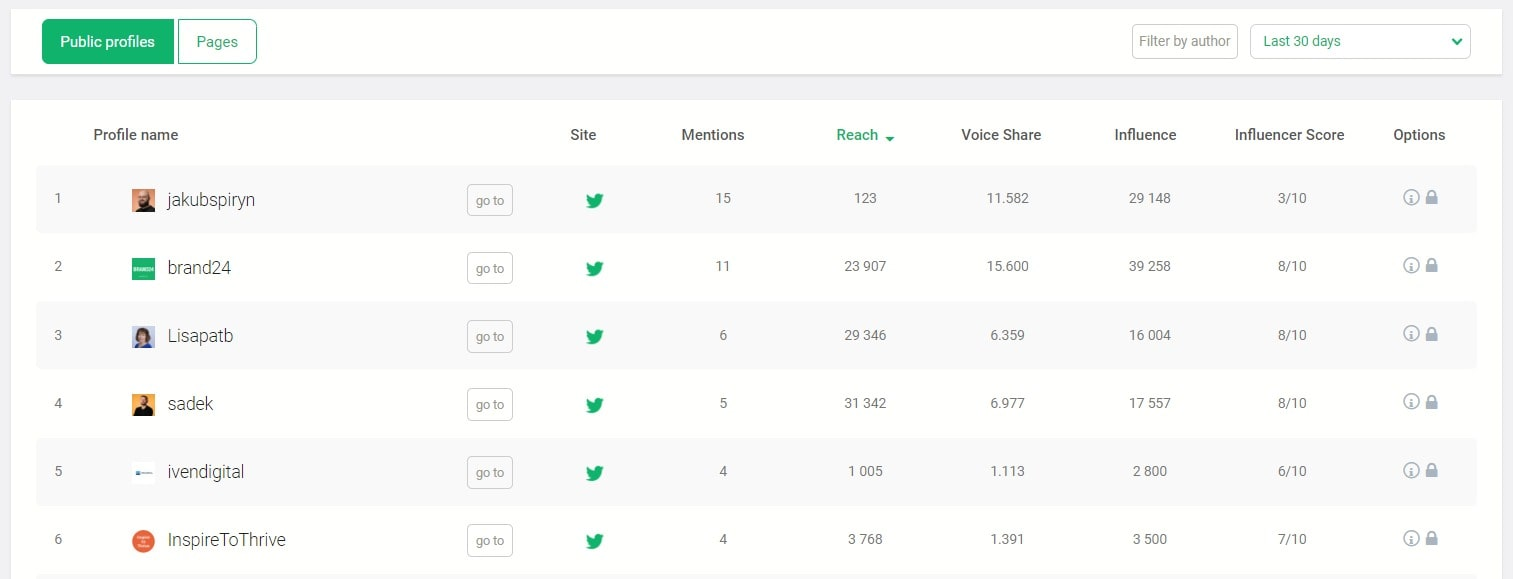
Twitter analytics don’t present in-depth followers data. To discover audience demographics, you can use a free plugin: Influencer Analytics by Upfluence.
It will show you Twitter audience demographics metrics such as:
- Gender
- Age
- Countries
- Cities
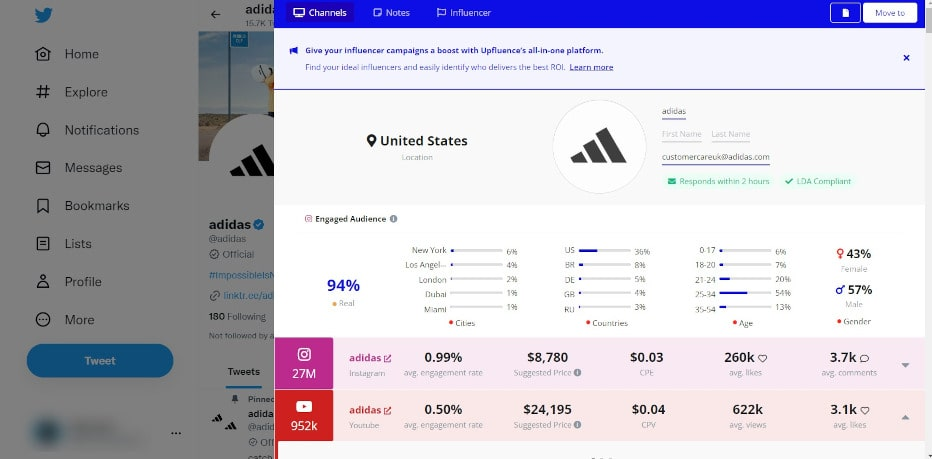
03 The volume of mentions
The volume of mentions shows how many times users mentioned your brand on Twitter within the predefined time range.
It tells you how often people talk about you or your business. If you’re getting mentioned less often, it’s a good idea to analyze your Twitter strategy and see what you can do to increase your visibility.
By tracking the volume of mentions, you can ensure that your Twitter presence has the desired effect.
How to track:
In the Twitter analytics dashboard, you can check the number of mentions in the last 28 days. You can’t set up a time range, nither check who mentioned you.
Want more dig into advanced data? You need to use a social media monitoring tool. Here’s how the Brand24 tool presents the volume of mentions:
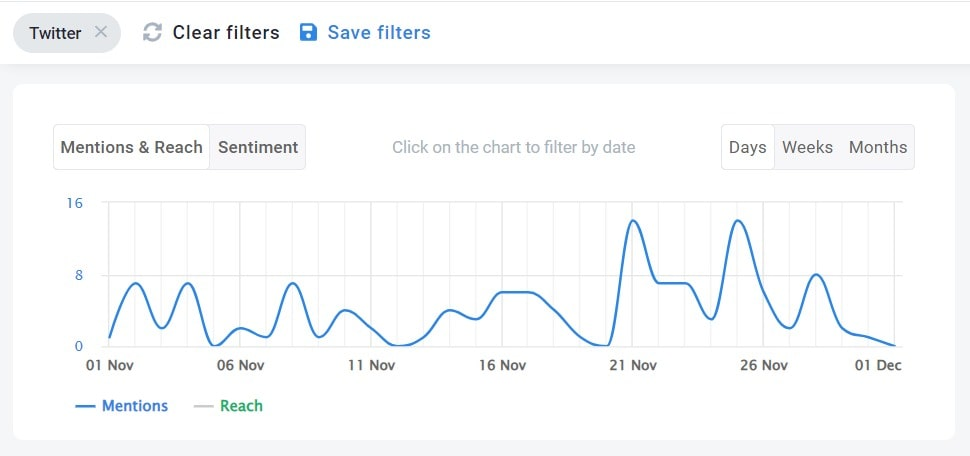
You can select a day or time range, and the tool will show you all published mentions, their social media reach, and sentiment.
04 The most popular Twitter mentions
It is definitely worth following the most popular Twitter mentions. Why? Because they have a significant impact on reach.
This can be a valuable metric for:
- Increasing the reach and influence of a Twitter account,
- Identifying potential customers or influencers to cooperate,
- Detecting emerging trends,
- Finding what kind of content is willingly sharable.
How to track:
In Twitter analytics, you can check one top mention. That’s all. So to discover more mentions, you need to use your Twitter monitoring tool.
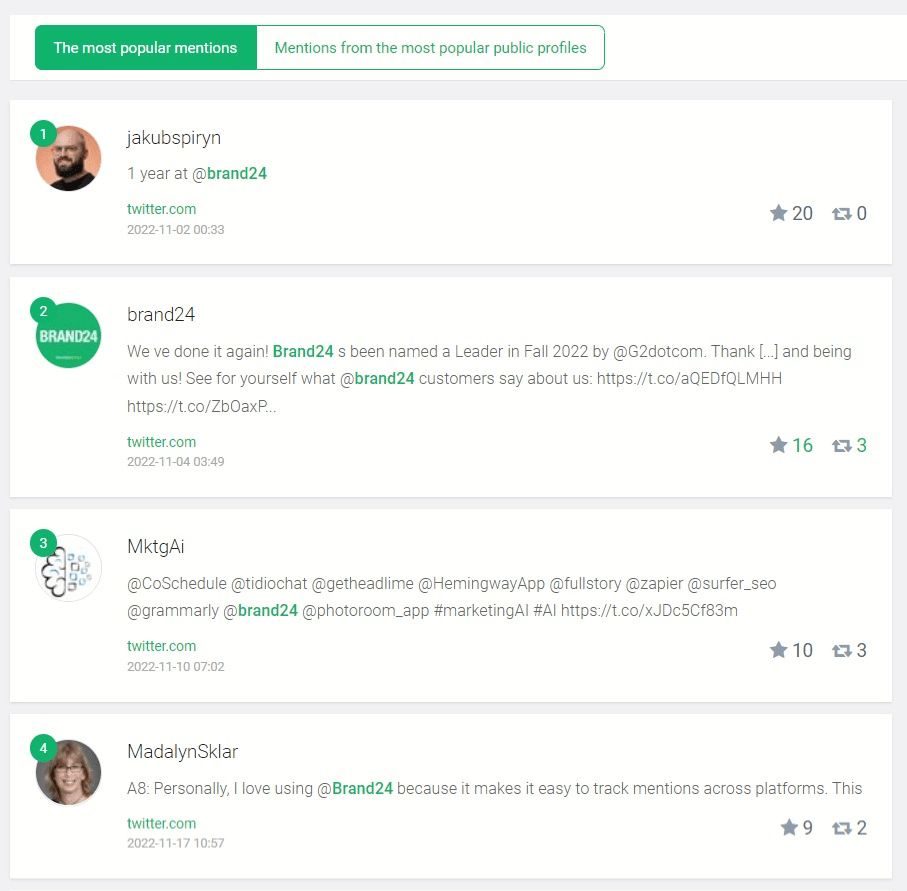
05 Social media reach on Twitter
Social media reach measures how many people see your tweets. The more people who see your content, the more likely it is that they will engage with it.
This metric will help to measure the success of marketing campaigns and assess the potential audience for a product or service.
How to track:
In Brand24, the volume of mentions correlates with another Twitter metric called social media reach.
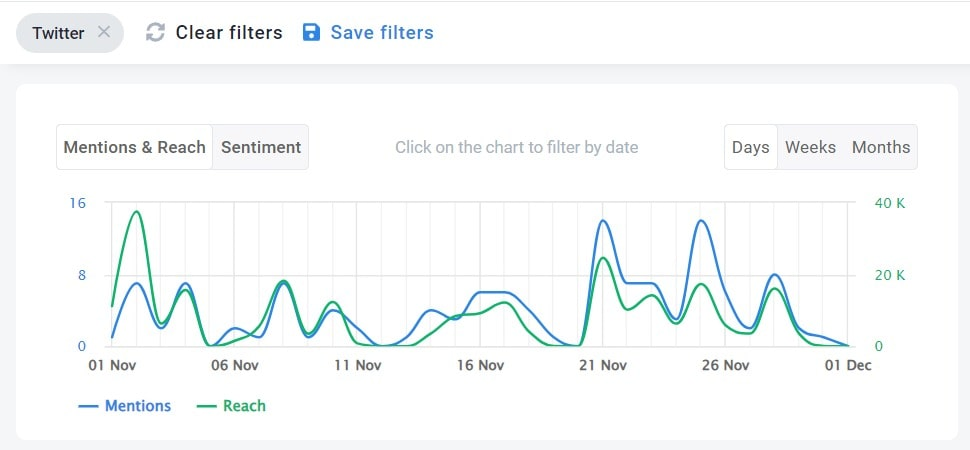
A social media reach is an estimated number of Twitter users who might have stumbled upon a tweet containing your keyword. In other words, the graph will show you how many people could have come into contact with your content.
The volume of mentions and social media reach will tell you whether your content is spreading to the right people.
A high volume of mentions and social media reach indicates that your Twitter message resonates well with your target audience.
06 Sentiment
Sentiment analysis can help brands to understand how their customers feel about their products or services. You can also use it to track changes in public opinion over time.
For example, if a brand notices a sudden spike in negative sentiment, it may indicate a problem that needs to be addressed. On the other hand, if sentiment is consistently positive, it could be a sign that the brand is doing something right.
How to track:
You need a tool that conducts Twitter sentiment analysis. It will categorize mentions as positive, negative, or neutral.
This is an example of a positive tweet:

This is an example of a negative tweet:

The ideal situation is prevailing positive sentiment. That way, you know that your content is well-received by your Twitter followers and that your product or service evokes positive emotions on Twitter.
In the Mentions tab, you’ll see a chart presenting the sentiment.
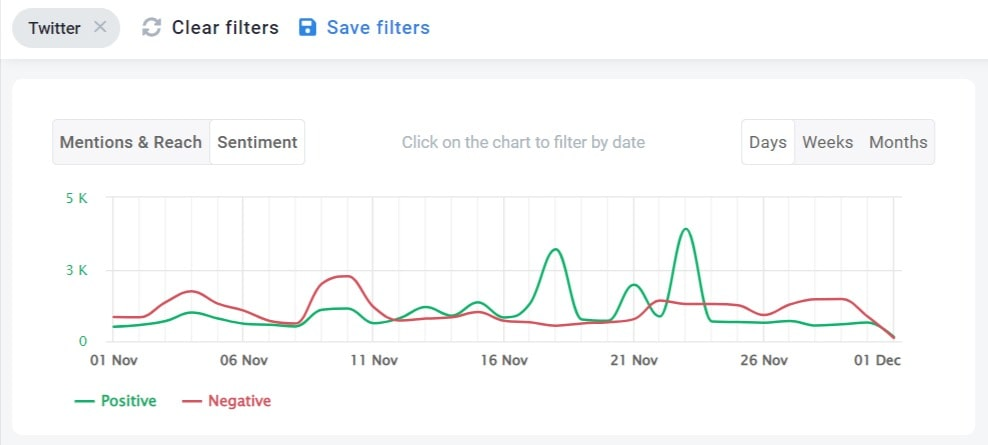
Monitor Twitter sentiment, reach, engagement, and other metrics!
07 Engagement
When it comes to Twitter analytics, engagement is one of the most important Twitter metrics. Actually, it is one of the key social media metrics. The whole point of being active on social media is to build meaningful relationships with your audience.
The more retweets, likes, and comments your posts receive, the higher the brand awareness. Of course, you can run Twitter ads to reach more users, but organic engagement is priceless.
The engagement has an impact on your position on Twitter. The algorithm ranks engaged tweets. They will appear higher in users’ news feeds. Of course, there’re many factors regarding the Twitter algorithm, but one of the most important ones is the Twitter engagement rate. The higher the engagement, the more followers will see your tweet.
How to track:
With a little help from Brand24. Take a look at the Summary tab. You will find the total number of interactions on the right side of the screen.
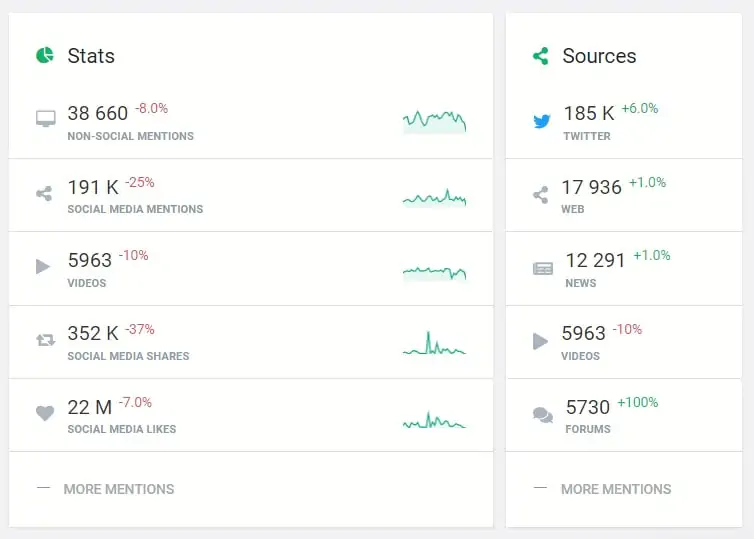
Twitter category of engagement
Engagement is quite a broad topic. To better understand your Twitter analytics, you need to know what type of engagement your tweets are generating.
There are three types of reactions that count as a Twitter engagement:
- Social media comments,
- Social media likes,
- Social media shares.
A comment or a retweet requires much more commitment than a thumbs-up. That’s why they count more when it comes to the Twitter algorithm.
A retweet shows that your customers value your content – they are not afraid to vouch for it with their social media authority. You can turn those followers into loyal customers or brand ambassadors.
08 Impressions
Twitter impressions refer to the number of times other users have seen your tweets.
By tracking this metric, you will discover how far your tweets are reaching. You will gain a better understanding of what is working and what needs to be improved.
How to track:
Each tweet has its own statistics that show the number of impressions, likes, retweets, follows, link clicks, detail expands, and profile clicks. You can check them in the Twitter analytics.
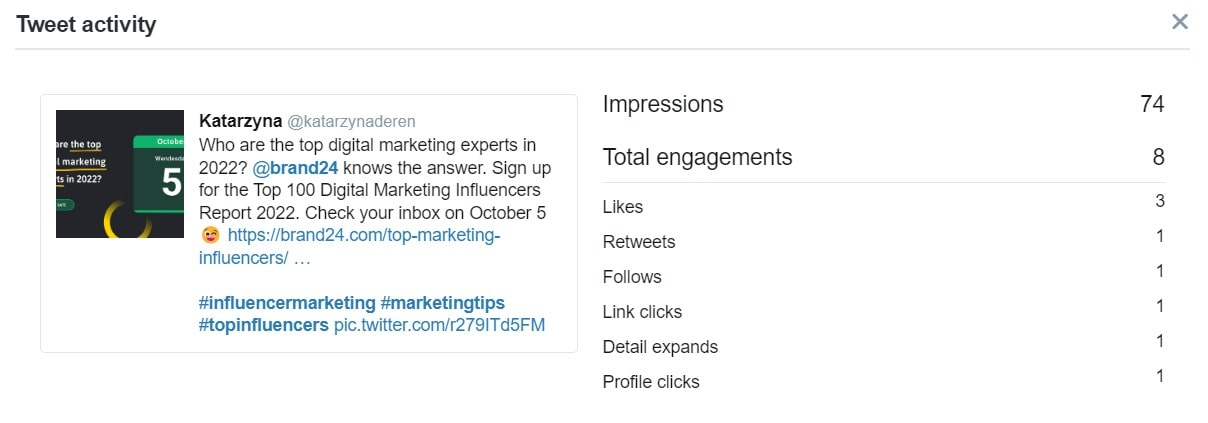
09 Video activity
Over the last few years, video has become the most important social media content format.
Twitter followers are increasingly watching videos, and Twitter is now measuring video activity as a key metric.
This data is helping Twitter to understand better how users interact with video content.
How to track:
You’ll find video statistics in the Twitter analytics dashboard.
10 Hashtag performance
What would Twitter be without hashtags? I bet it’s hard to imagine this platform without the pound sign.
Hashtags are your ally when it comes to monitoring the performance of your Twitter campaigns. That’s why it’s important to set up a separate project with the hashtag as a keyword.
You’ll find all the interesting Twitter analytics in the Analysis tab. You will see metrics like:
- Estimated social media reach;
- Social media interactions;
- The total number of positive and negative mentions.
But that’s only the beginning!
Based on the hashtag performance, you can identify the influencers in your niche to work with and even generate a list of trending hashtags you could implement into your Twitter strategy.
Check: Twitter Hashtag Analytics
Why should you track Twitter metrics?
01 To improve the visibility of your Tweets
Twitter metrics will help you use its algorithm to your favor.
Twitter introduced an algorithm because there was so much content it was impossible for users to interact with all of it. Social media channels had to choose the most engaging content and show it first.
Some Twitter metrics could positively or negatively impact your reach.
For example, a high engagement rate will likely boost your social media presence. It’s a sign from the Twitter AI algorithm that Twitter users like your posts and want to see more of them. The more impressions your content generates, the bigger the chance it will appear in your audience feed.
Tracking Twitter metrics regularly will help you determine any spikes or decreases in the engagement metrics of your tweets. Changes like that mean you are either nailing your Twitter marketing strategy or need to alter it so it meets the needs of your followers. Checking your tweet activity dashboard should be your bread and butter.
02 To optimize your Twitter marketing campaign
Optimization, optimization, optimization!
Your audience expects to see different content on your account — videos, regular tweets, contests, and so on.
Tracking Twitter metrics should give you a general understanding of what works and what doesn’t for your audience. You can keep an eye on the most important KPIs and react in time to any negative changes. For example, if you see a decline in the number of impressions or video views, you might want to tweak your content a bit.
Spotting downward trends in the early stages are your greatest weapon against any changes in the Twitter algorithm.
03 To set up Twitter benchmarks
Following Twitter metrics closely will help you set up your benchmarks. Knowing how your tweets perform on average will help you spot any deviations right away.
Benchmarks are incredibly helpful when it comes to the assessment of your Twitter presence.
You’ll see right away how your audience reacts to your recent activities. Making your decision on Twitter metrics will help you improve your Twitter activities.
Moreover, setting benchmarks will help you compare your Twitter account performance to your competitors. Tracking engagement metrics and other KPIs will help you assess whether your strategy is working.
Monitor Twitter sentiment, reach, engagement, and other metrics!
Top Twitter metrics that matter
As you can see, there are a variety of Twitter metrics that Marketers should pay attention to.
As you track these metrics over time, you’ll be able to see which tactics are working well and adjust your strategy accordingly.
Key takeaways:
- Pick those metrics that match your business goals,
- Set benchmarks,
- Choose the right Twitter analytics tool,
- Track your metrics regularly.
FAQ
What are the metrics of Twitter?
Twitter offers several metrics to help users track the performance of their accounts and campaigns. Some of the key metrics include:
Followers: The number of people who follow a Twitter account.
Impressions: The number of times a tweet was displayed on a user’s Twitter feed.
Engagement: The number of interactions with a tweet, including likes, retweets, replies, and clicks.
Retweets: The number of times a tweet was shared by other users.
Replies: The number of direct responses to a tweet.
Mentions: The number of times a Twitter account was mentioned by other users.
Hashtag performance: The number of times a hashtag was used, as well as the reach and engagement of the associated tweets.
Audience demographics: Information about the gender, location, and interests of a Twitter account’s followers.
What is the most important metric on Twitter?
Engagement is the most important metric for Twitter campaigns, as it measures how well the campaign is resonating with the target audience and can help drive awareness, loyalty, and conversions.
What a is good engagement rate on Twitter?
A good engagement rate on Twitter can vary depending on the industry, audience, and content type. However, as a general guideline, an average engagement rate of 1-3% is considered good on Twitter.
For Twitter advertising, a higher engagement rate is desirable to ensure that the campaign is reaching and resonating with the target audience. A good average engagement rate for Twitter ads is around 1-5%, although this can also depend on the campaign objectives and target audience.
Want to track top Twitter metrics effectively? Try Brand24.



